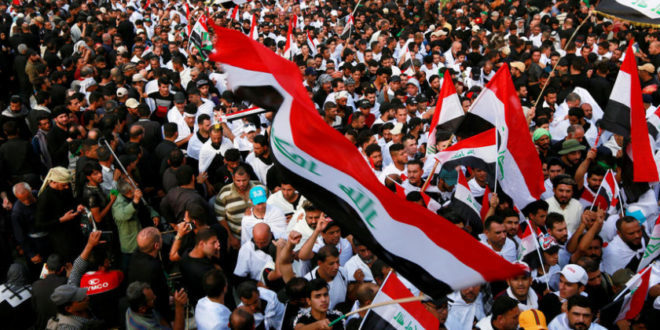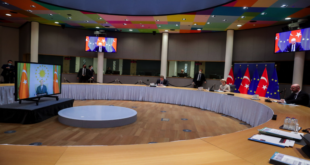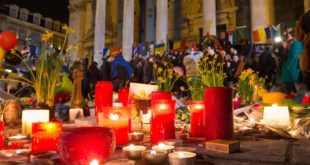Musical chairs in the Iraqi parliament can no longer solve the country’s problems.
By John Hannah, for the Foreign Policy (*)
The United States faces an increasingly urgent set of first-order policy questions in Iraq. Spoiler alert: The answer is not Mohammed Tawfiq Allawi, Iraq’s newly designated prime minister. A popular uprising might be.
Allawi’s recent nomination to be Iraq’s next leader is a dead end, for Iraq and the United States alike. He has no chance of resolving the two fundamental crises now plaguing the country: first, the collapse of legitimacy of Iraq’s post-2003 political class, and second, Iraq’s ever-expanding subjugation by Iran and its local Shiite Islamist proxies. The United States would be well advised to keep its distance from Allawi’s candidacy and instead focus its energies on supporting the extraordinary protest movement that has upended Iraq’s politics since late last year, and whose demands for sovereignty, independence, and clean government represent the last best hope for salvaging not just Iraq, but the future of U.S.-Iraqi relations as well.
It is hard to overstate the importance of the mass demonstrations that erupted in Baghdad on Oct. 1, 2019, and rapidly spread to every major city in southern Iraq. Dominated by young people (close to 60 percent of Iraq’s population is now under 25), the protesters are overwhelmingly Shiites—Iraq’s largest religious sect. But from the beginning, they have called for a complete overhaul of the Shiite-dominated regime that has ruled them since the fall of Saddam Hussein, charging it with being irredeemably corrupt, incompetent, and fatally infected by sectarianism, Islamism, and Iranian penetration.
Whether or not the protesters’ anger could have been assuaged by a rapid and sincere effort to engage their demands, we’ll never know. Instead, the government almost immediately chose the path of brutal repression—killing, maiming, and terrorizing its own citizens with a vengeance and on a scale that made Hong Kong’s protests seem like child’s play. In waves of violence over the past four months, hundreds of people have been killed, abducted, tortured or disappeared. Around 20,000 have been injured.
In the process, an insular and out-of-touch political class that for the better part of two decades had systematically looted the nation’s enormous patrimony to line its own pockets was exposed in all its venality, cruelty, and criminality. Confronted in a moment of acute crisis with the stark choice of siding with its people or protecting its own power and privilege, the post-2003 governing establishment opted to go down the path of killing and brutalizing its youth, or at best standing by mutely and watching while others did the dirty work. A few politicians ineffectually tut-tutted from the sidelines, expressed concern, urged restraint. But no one resigned in protest. No one joined the demonstrators. No one called out the assassins by name. No one was held to account.
Making matters worse, the government’s decision to kill was so clearly orchestrated by a foreign power, Iran, and in large part executed by its Iraqi proxies, including a group of powerful Shiite militias known as the Popular Mobilization Forces, or PMF. Before he was killed by an American Hellfire missile last month, Qassem Suleimani—the Iranian general in charge of the Quds Force, the special operations branch of the Islamic Revolutionary Guard Corps (IRGC)—was widely known to be chairing meetings in Baghdad to map out the government’s battle plan for repressing the protests, imperially usurping the authority of Iraq’s elected leaders. And when Suleimani was not in town, his power was dutifully delegated to his most trusted Iraqi lieutenant, Abu Mahdi al-Muhandis, the operational commander of the PMF who (before dying in the same missile strike that killed Suleimani) had for years unabashedly made clear that his primary loyalties ran not to Iraq but to Suleimani and the Iranian revolution.
The protests laid bare for all to see the unholy alliance that now exists between the post-2003 Iraqi governing class and the regime in Iran. Years in the making, it rapidly accelerated with the rise of the PMF during the war against the Islamic State and the wholesale integration of Shiite militias, de facto foreign legions of the IRGC, into Iraq’s security forces as well as the highest echelons of the government.
The so-called Hezbollah-ization of Iraq was already well down the road to completion when the protests first broke out. With the government’s decision to kill rather than reform, to succumb with varying degrees of enthusiasm to the plots of Iran and its loyalists to crush a popular movement grounded in Iraqi nationalism, the process now seems nearly irreversible. A Rubicon of sorts has been crossed. Too much innocent blood has been spilled for the Iraqi political class to go back now. Whether out of ideological fealty, intimidation, bribery, greed or other reasons too numerous to mention, its members have collectively made their bed with the Iranian regime.
For all its myriad failings, including not delivering minimally competent governance and not protecting Iraqi sovereignty from foreign predators, Iraq’s political class has been unambiguously rejected en masse by the protesters. Week after week, month after month, they have without deviation made clear that there can be no solution to the current crisis that leaves any of those from the post-2003 order in charge of the system’s overhaul.
What they appear to want instead is the creation of some kind of transitional authority, blessed by the protesters and composed of well-regarded people without ties to the existing governing elite, that will work on a rapid timeline to implement sweeping emergency measures that pave the way for truly free and fair elections (perhaps with coordination and oversight from the United Nations), while banishing Iraq’s current crop of corrupt rulers, Islamist parties, and Iranian toadies to the political margins.
That is a very tall order. What it means in practice or how it can be achieved in ways consistent with the rule of law is far from clear. But what it almost certainly doesn’t mean is Mohammed Tawfiq Allawi’s designation as Iraq’s next prime minister.
Allawi is an Islamist-leaning Shiite and former member of parliament who served two stints as Iraq’s minister of communications. In cabinets filled with thieves and hacks, he was reputedly less corrupt and incompetent than most of his colleagues. Like the man he would now replace, Adil Abdul-Mahdi, Allawi is reportedly more of a longtime bureaucrat than a political power broker, claiming no party affiliation and lacking any independent base of support. But also like Abdul-Mahdi, he is inescapably a man of the post-2003 system, not outside it. Which is why, from the moment Allawi’s potential nomination surfaced, the protesters have loudly and consistently rejected it out of hand.
Not helping Allawi’s cause was the fact that his candidacy so brazenly emerged out of a backroom deal cut—where else?—in Iran between Hadi al-Amiri and Muqtada al-Sadr, two pillars of Iraq’s dysfunctional system of Islamist spoils and militias run wild. Amiri, who fought for Iran during the Iran-Iraq War, heads both a major faction in Iraq’s parliament as well as the IRGC-backed Badr militia, which has controlled Iraq’s Interior Ministry for years and has played a leading role in repressing the current protests. Sadr, a populist anti-American cleric, while a more mercurial figure, has been no less a staple of Iraq’s increasingly toxic post-2003 order, milking government ministries and wielding a murderous militia to bolster the wealth and power of his own political movement and cult of personality. The protesters fully comprehend that, with a provenance so clearly dependent on the likes of Amiri and Sadr, Allawi’s appointment was concocted in sin, not for the purpose of transforming Iraq’s broken system, but to save it.
It didn’t take long for the sordid reality surrounding Allawi’s nomination on Feb. 1 to be exposed. While Allawi issued a conciliatory statement praising the protesters and promising to hold their oppressors to account, Sadr at that very moment was dispatching his militia to attack the demonstrations, shut them down, and crack the heads of those speaking out against Allawi’s designation. In Baghdad and protest centers across southern Iraq, Sadr’s thugs went on a weeklong rampage of beatings, arsons, and killings. After a particular bloody day in Najaf on Feb. 5, Allawi called on Abdul-Mahdi’s caretaker government to protect the protests until he could form a new cabinet that would fulfill the people’s demands. But there was not a word against the Sadrists openly perpetrating the atrocities in the name of his appointment. Not a word demanding that his political patron, Sadr, call off his assault and deliver those in his ranks responsible for the mayhem to the authorities for punishment. Quite predictably, Sadr’s forces were back at it the following day in Karbala, leaving more death and destruction in their wake.
Hard as it might be given the United States’ pivotal role in establishing Iraq’s post-2003 order, the Trump administration now needs to come to grips with the challenging reality that the Iraqi regime as currently constituted is increasingly not a viable partner for advancing U.S. interests. While the situation was deeply worrisome even before the onset of the protests, events since this past October have left little room for doubt. For the first time since 2003, the Iraqi government has systematically unleashed widespread violence against its own unarmed citizens whose demands for democratic change and Iraqi sovereignty largely align with U.S. interests and values. The government’s legitimacy, already a rapidly wasting asset, has now been shattered in the eyes of the Iraqi people, probably irreparably. Its efforts to preserve its prerogatives at all costs by waging a bloody war of attrition against its own citizenry is a prescription for chronic instability and conflict.
Even more directly threatening to U.S. interests has been the government’s ever-deepening submission to its eastern neighbor. The dominating role that Iran and its militia proxies have played in directing and executing the violence against the protests has been disturbing enough. But it has been simultaneously coupled with the government’s abject acquiescence in an escalating Iranian campaign to attack the U.S. military and diplomatic presence in Iraq.
In the final weeks of 2019, Iran’s militia allies conducted at least 11 increasingly dangerous rocket attacks against facilities hosting U.S. forces that have been supporting the Iraqi Army’s fight against the Islamic State. After each incident, U.S. officials implored Iraqi authorities to condemn the attacks and take action against them. The government did nothing. U.S. pleas went ignored. But when an attack on Dec. 27 killed an American contractor (crossing an unambiguous red line repeatedly articulated by the Trump administration) and the United States retaliated against Kataib Hezbollah, one of Iran’s most powerful Shiite proxies under Muhandis’s command, senior Iraqi officials rushed to publicly condemn the United States for its dangerous and unacceptable violation of Iraqi sovereignty.
More shocking still was the assault on the U.S. Embassy in Baghdad days later. On Dec. 31, Iraqi security forces opened the gates of the Green Zone (the heavily guarded area housing government offices and diplomatic compounds) to allow a mob of thousands of pro-Iranian militia members to lay siege to the embassy’s perimeter, breaching external walls, laying waste to guardhouses, and setting fires. Embassy personnel retreated to safe rooms while heavily armed but outnumbered U.S. Marines steeled themselves to repel a potential assault à la Tehran in 1979 or Benghazi in 2012. Rather than taking any action to prevent a potential catastrophe and uphold its international obligations to protect diplomatic facilities, the Iraqi government sat on its hands for hours while many of its most powerful officials, including Muhandis and Amiri, openly joined the mob to egg on the rioters.
While the militias eventually withdrew and the nightmare scenario was averted, it was a near-miss thing and no thanks to the Iraqi government. Quite the contrary. Instead, what transpired was an astonishing real-time display of how deep the rot of Iranian penetration had set in among Iraq’s governing elite, as it appeared to cross a fateful line from pathetic passivity in the face of Iran’s incessant assaults on U.S. interests to something much more resembling active complicity.
Needless to say, that is an intolerable situation. A policy premised on partnering with the Iraqi state is simply not sustainable when, at its highest political and security echelons, that government’s payroll and power structures are increasingly dominated by U.S.-designated individuals and armed groups whose primary allegiances are to an Iranian regime that is systematically working to inflict great harm on the United States. Nor is it sustainable when, necessary as it might have been, the United States is forced into the position of droning convoys on major Baghdad highways carrying senior Iraqi and Iranian military commanders openly conspiring to attack US interests.
What an alternative U.S. policy should be is, of course, a much harder question. It’s certainly worthy of an urgent review by President Donald Trump’s national security team. One hopes that’s being done. The new situation triggered by the protests requires deep analysis, questioning old assumptions, and the development of new policy options.
As a general proposition, a good starting point would probably be to invest less in the Iraqi government and more in the protest movement. Within the deeply flawed confines of the post-2003 order, the game of musical chairs in Baghdad to get this prime minister or that group of cabinet officials appointed has proved over the long term to be a losing proposition for the United States. That’s Iran’s favored turf, and its clear result has been both the slow-motion discrediting of Iraqi democracy and the accelerating Hezbollah-ization of the Iraqi state. Allawi’s nomination and whatever cabinet Iran and its loyalists permit him to cobble together will likely do nothing to change that trajectory, and the United States should act accordingly.
The protest movement, in contrast, is an historic challenge to all that Iran has perpetrated in Iraq. It’s true that the protesters have no love lost for an America that they blame for saddling them after 2003 with a botched occupation and a failed political system. But watch videos of the demonstrations closely and it wasn’t posters of Donald Trump that they were trampling day in and day out. It was pictures of Qassem Suleimani and Iran’s Supreme Leader Ali Khamenei. They weren’t burning down U.S. and British diplomatic facilities across the Shiite heartland but Iranian consulates and the headquarters of Iran’s most important Iraqi allies. Yes, especially after the targeted killings of Suleimani and Muhandis, the protesters did make a point of coupling their standard chant of “No, no Iran” with “No, no America.” But talk to them confidentially and they will admit that including the United States is largely a means of reducing the risk of being attacked by Iran’s unforgiving proxies.
The fact is that at their core, in addition to being an uprising against corrupt and inept governance, the protests are quite clearly a mass movement of Iraqi nationalism targeting Iranian malign interference, not American.
How to engage and support the protest movement, leaderless and inchoate as it is, without inadvertently tainting and endangering it is a genuinely difficult policy challenge. But that is increasingly where the energies and attention of U.S. policymakers should be focused. There should be a concerted campaign to keep the eyes of the world on the protests and the Iranian-backed attacks against them. Together with allied governments, Washington should sponsor statements and resolutions in the U.N. Security Council and other multilateral forums expressing solidarity and concern for the Iraqi people; find ways to assist Iraqi and international nongovernmental organizations that are working discreetly with the protesters to channel their movement and demands into a practical political program; help the protesters gain access to secure communications technologies for defeating internet shutdowns by the government; and accelerate the sanctioning of the protesters’ oppressors—including not just militia leaders but also major politicians such as Amiri, Sadr, and their key lieutenants, whose destabilizing actions had heretofore gotten a U.S. pass—for transgressions that mirror the movement’s main complaints, particularly corruption, human rights abuses, and facilitating Iranian malign influence. Finally, discreetly and in cooperation with its most reliable Iraqi and international partners, the U.S. government should make necessary adjustments now to its troop deployments in Iraq to limit their exposure during the country’s present upheaval while maintaining maximum flexibility to fulfill essential counterterrorism missions and respond aggressively to Iranian provocations.
Acknowledging that a longtime policy may have passed its sell-by date is rarely easy. Policy inertia is a powerful force, and large bureaucracies are almost always resistant to major changes in direction—especially when it comes to things like Iraq’s post-2003 political order that the United States did so much to create. But major events are afoot now in Iraq that cry out for serious reevaluation. Not only are important U.S. interests are at stake, but, as we’ve seen repeatedly in recent weeks, the lives of U.S. troops and diplomats are increasingly at risk as well. Recognizing the need for a significant shift in approach is the critical first step toward building a more sustainable and effective long-term Iraq policy, even if comes at the expense of acknowledging that Washington’s approach since 2003 has largely been a failure.
_____________________________________________________
(*) This article was originally published on Foreign Policy. Read the original article. The views expressed in this article belong to the author and do not necessarily represent ForMENA
 ForMENA Council for MENA affairs
ForMENA Council for MENA affairs



